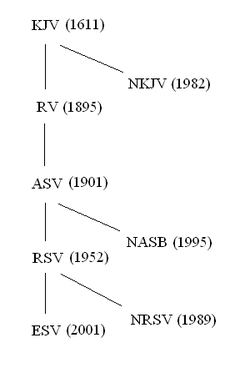Dynamic and formal equivalence
The terms dynamic equivalence and formal equivalence, coined by Eugene Nida, are associated with two dissimilar translation approaches that are employed to achieve different levels of literalness between the source text and the target text, as evidenced in biblical translation.
| Part of a series on |
| Translation |
|---|
 |
| Types |
| Theory |
| Technologies |
| Localization |
|
| Institutional |
|
| Related topics |
|
The two have been understood basically, with dynamic equivalence as sense-for-sense translation (translating the meanings of phrases or whole sentences) with readability in mind, and with formal equivalence as word-for-word translation (translating the meanings of words and phrases in a more literal way), keeping literal fidelity.
Approaches to translation
Formal equivalence approach tends to emphasize fidelity to the lexical details and grammatical structure of the original language, whereas dynamic equivalence tends to employ a more natural rendering but with less literal accuracy.
According to Eugene Nida, dynamic equivalence, the term as he originally coined, is the "quality of a translation in which the message of the original text has been so transported into the receptor language that the response of the receptor is essentially like that of the original receptors."[1] The desire is that the reader of both languages would understand the meanings of the text in a similar fashion.
In later years, Nida distanced himself from the term "dynamic equivalence" and preferred the term "functional equivalence".[2][3][4] What the term "functional equivalence" suggests is not just that the equivalence is between the function of the source text in the source culture and the function of the target text (translation) in the target culture, but that "function" can be thought of as a property of the text. It is possible to associate functional equivalence with how people interact in cultures.
Theory and practice
Because functional equivalence approach eschews strict adherence to the grammatical structure of the original text in favor of a more natural rendering in the target language, it is sometimes used when the readability of the translation is more important than the preservation of the original grammatical structure.
Formal equivalence is often more goal than reality, if only because one language may contain a word for a concept which has no direct equivalent in another language. In such cases, a more dynamic translation may be used or a neologism may be created in the target language to represent the concept (sometimes by borrowing a word from the source language).
The more the source language differs from the target language, the more difficult it may be to understand a literal translation without modifying or rearranging the words in the target language. On the other hand, formal equivalence can allow readers familiar with the source language to analyze how meaning was expressed in the original text, preserving untranslated idioms, rhetorical devices (such as chiastic structures in the Hebrew Bible) and diction in order to preserve original information and highlight finer shades of meaning.
Bible translation
Translators of the Bible have taken various approaches in rendering it into English, ranging from an extreme use of formal equivalence, to extreme use of dynamic equivalence.[5]
- Predominant use of formal equivalence

- Douay-Rheims Bible (1610)
- King James Bible (1611)
- Young's Literal Translation (1862)
- Revised Version (1885)
- American Standard Version (1901)
- Concordant Version (1926)
- Revised Standard Version (1952)
- Revised Standard Version Catholic Edition (1966)
- New American Standard Bible (1971)
- New King James Version (1982)
- Green's Literal Translation (1985)
- New Jewish Publication Society Tanakh (1985)
- New Revised Standard Version (1989)
- Orthodox Study Bible (1993)
- Third Millennium Bible (1998)
- Recovery Version (1999)
- World English Bible (2000)
- English Standard Version (2001)
- Revised Standard Version Second Catholic Edition (Ignatius Bible) (2006)
- Lexham English Bible (2011)
- Modern English Version (2014)
- Tree of Life Version (2014)
- English Standard Version Catholic Edition (Augustine Bible) (2018)
- Moderate use of both formal and dynamic equivalence (optimal equivalence)
- The Holy Bible: Knox Version (1949)
- New World Translation of the Holy Scriptures (1961, revised 1984, 2013)[6]
- Confraternity Bible (1969)
- Modern Language Bible (1969)
- New American Bible (1970, revised 1986 & 1991)
- New International Version (1978, revised 1984 & 2011)
- New International Reader's Version (1996)
- New Living Translation (1996)
- Holman Christian Standard Bible called "optimal equivalence" (2004)
- Today's New International Version[7] (2005)
- New English Translation (2005)
- New American Bible Revised Edition (2011)
- Christian Standard Bible (2017)
- Evangelical Heritage Version (2019)
- New Catholic Bible / New Catholic Version[8] (St. Joseph New Catholic Bible) (2019)
- Revised New Jerusalem Bible (2019)
- Extensive use of dynamic equivalence or paraphrase or both
- Amplified Bible (1965)
- Jerusalem Bible (1966)
- New Life Version (1969)
- New English Bible (1970)
- Good News Bible (formerly "Today's English Version") (1976)
- New Jerusalem Bible (1985)
- Christian Community Bible (1988)
- Revised English Bible (1989)
- God's Word Translation (1995)
- Contemporary English Version (1995)
- Complete Jewish Bible (1998)
- CTS New Catholic Bible (2007)
- New Community Bible (2008)
- The Voice (2012)
- Extensive use of paraphrase
- The Living Bible (1971)
- The Message Bible (2002)
See also
- Bible concordance
- Lexical markup framework
- The Bible version debate
- Translation
- Textualism in jurisprudence:
- Original meaning (cf. formal equivalence)
- Original intent (cf. dynamic equivalence)
- Purposivism (also called purposive theory)
References
- Nida, Eugene A., and Charles R. Taber. (1969). The Theory and Practice of Translation, With Special Reference to Bible Translating, 200. Leiden: Brill.
- Let the words be written: the lasting influence of Eugene A. Nida p. 51 Philip C. Stine – 2004 "That probably would not have happened if it hadn't been for Nida's ideas" (Charles Taber, interview with author, 21 Oct. 2000).7 Nida later felt that the term "dynamic equivalence" had been misunderstood and was partly responsible for
- Translation and religion: holy untranslatable? p91 Lynne Long – 2005 "In order to avoid certain misunderstandings, de Waard and Nida (1986: 7, 36) later replaced the term 'dynamic equivalence' with 'functional equivalence', but they stated clearly that 'The substitution of "functional equivalence"' is not..."
- The History of the Reina-Valera 1960 Spanish Bible p98 Calvin George – 2004 "190 For this reason in his later writings he distanced himself from the term 'dynamic equivalence,' preferring instead 'functional equivalence.' 191 The idea is to produce the closest natural equivalent in the target or 188 190 Nida, ..."
- Data collected from two sources that have nearly identical ranking with an overlapping (supplemental) list of translations studied: 1. Thomas, Robert L., Bible Translations: The Link Between Exegesis and Expository Preaching, pages 63ff; and 2. Clontz, T.E. and Clontz, J., The Comprehensive New Testament, page iii.
- "Principles of Bible Translation from Hebrew and Greek | NWT". JW.ORG. Retrieved 2017-09-04.
- Barker, Kenneth L. "The Balanced Translation Philosophy of the TNIV". Archived from the original on 2007-10-21. Retrieved 2007-11-29.
- {url=https://catholicbookpublishing.com/new-catholic-bible}